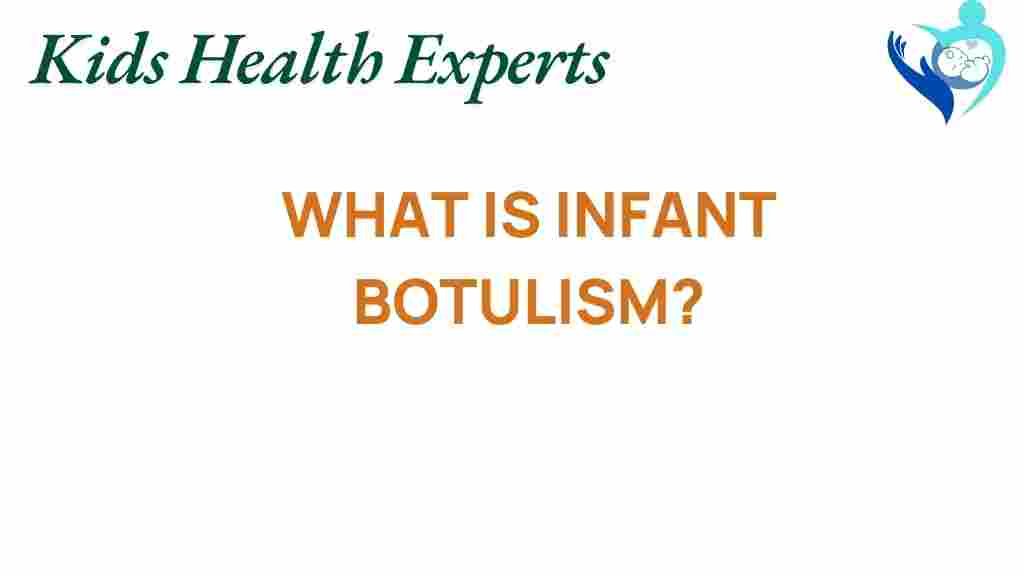Unveiling Infant Botulism: A Hidden Threat to Newborns
In recent years, awareness of infant botulism has grown, but many caregivers remain unaware of its serious implications for newborn health. This bacterial infection, caused by the toxin produced by the bacteria Clostridium botulinum, poses significant risks to infants under 12 months of age. Understanding the symptoms, prevention methods, and treatment options is crucial for ensuring infant safety. This article delves into the intricacies of infant botulism, aiming to equip caregivers with the knowledge needed to protect their little ones.
What is Infant Botulism?
Infant botulism is a rare but potentially life-threatening condition that occurs when infants ingest spores of Clostridium botulinum. These spores can germinate and produce toxins in the intestines of babies, leading to severe illness. Unlike adults, infants have immature digestive systems that are unable to handle these spores effectively.
Symptoms of Infant Botulism
- Constipation: This is often the first sign, with infrequent bowel movements and hard stools.
- Weakness: Babies may exhibit reduced muscle tone, appearing floppy or lethargic.
- Poor feeding: Infants may struggle to suck or feed as they usually do.
- Difficulty swallowing: This can lead to choking or gagging.
- Respiratory distress: In severe cases, babies may have trouble breathing.
- Facial weakness: This can manifest as a drooping face or a weak cry.
If you notice these symptoms in your infant, seek immediate medical attention. Early diagnosis and treatment can significantly improve outcomes.
Understanding the Causes: How Does Infant Botulism Occur?
Infant botulism primarily occurs from the ingestion of spores found in honey, soil, and dust. These spores can also be present in certain foods, particularly those that are not properly processed. The spores germinate in an infant’s intestines, producing the botulinum toxin that leads to illness.
Prevention of Infant Botulism
Preventing infant botulism is essential for ensuring newborn health. Below are effective prevention strategies:
- Avoid honey: Do not give honey to infants under 12 months of age, as it is a known source of botulinum spores.
- Practice food safety: Ensure that all foods given to infants are properly prepared, cooked, and stored. Avoid giving them foods that may pose a risk, such as unpasteurized products.
- Good hygiene: Wash hands thoroughly before handling food or feeding infants. Keep surfaces and utensils clean.
- Educate caregivers: Raising awareness among family members and caregivers about infant safety can help prevent exposure to harmful foods.
Treatment for Infant Botulism
If an infant is diagnosed with infant botulism, treatment typically involves hospitalization. Here’s what you can expect:
- Supportive care: This may include respiratory support, intravenous fluids, and monitoring vital signs.
- Antitoxin therapy: In some cases, an antitoxin may be administered to neutralize the botulinum toxin in the bloodstream.
- Long-term follow-up: Recovery can take time, and ongoing follow-up with healthcare providers is essential to monitor for any lingering effects.
Food Safety Practices to Prevent Infant Botulism
Practicing proper food safety is a critical aspect of preventing infant botulism. Here are some important food safety tips:
- Always check labels: When purchasing baby food, ensure that it is from a reputable source and free from potential hazards.
- Store food properly: Refrigerate or freeze leftovers promptly to prevent bacterial growth.
- Cook food thoroughly: Ensure that all food given to infants is cooked to safe temperatures to kill any harmful bacteria.
- Avoid homemade foods: Homemade baby foods can sometimes contain harmful bacteria; it’s safer to use commercially prepared options.
Caregiver Awareness: Understanding the Risks
For caregivers, awareness is the first step toward prevention. Here are some key points to consider:
- Know the risks: Understanding what foods and environmental sources may contain botulinum spores is crucial.
- Educate yourself: Stay informed about the latest guidelines and recommendations regarding infant nutrition and safety.
- Communicate with healthcare providers: Regular check-ups can help monitor your baby’s health and address any concerns regarding bacterial infection.
Step-by-Step: What to Do If You Suspect Infant Botulism
If you suspect that your infant may have infant botulism, follow these steps:
- Assess symptoms: Look for signs such as constipation, weakness, and poor feeding.
- Contact a healthcare provider: Describe the symptoms and any potential exposure to foods that may contain botulinum spores.
- Follow medical advice: If advised, take your infant to the hospital for evaluation and treatment.
- Keep records: Document any foods your infant has consumed and any symptoms observed to aid in diagnosis.
Troubleshooting Tips for Caregivers
Caregivers often face challenges when ensuring infant safety. Here are some troubleshooting tips:
- If your baby is constipated: Consult with your healthcare provider for safe dietary adjustments.
- If feeding difficulties arise: Seek help from a pediatrician or a lactation consultant for guidance on feeding techniques.
- If your baby shows signs of weakness: Do not wait; seek immediate medical attention.
Conclusion
Understanding infant botulism is crucial for every caregiver to ensure newborn health. By being aware of the symptoms, implementing effective prevention strategies, and knowing the treatment options, you can safeguard your baby from this hidden threat. Remember, knowledge is power when it comes to infant safety. For more information on infant health, consider visiting reputable health resources or consulting with your pediatrician. Together, we can keep our infants safe from bacterial infections and other health risks.
For further reading on infant health and safety, check out this external link: Infant Health Guidelines.
For more tips on child safety, visit our internal link: Child Safety Tips.
This article is in the category Conditions and created by KidsHealthExperts Team

1 thought on “Unveiling Infant Botulism: A Hidden Threat to Newborns”